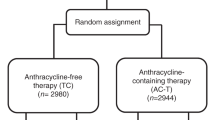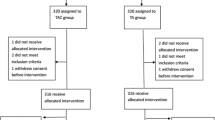Abstract
Purpose
Standard adjuvant chemotherapy for HER2-negative breast cancer consists generally in an anthracycline and taxane-based regimen (A+T). The TC (docetaxel and cyclophosphamide) regimen arises as a potential alternative, although individual randomized controlled trials (RCTs) could not demonstrate the non-inferiority of TC over A+T. This is a systematic review and meta-analysis of RCTs comparing 6 cycles of TC versus sequential A+T in the adjuvant treatment of HER2-negative breast cancer.
Methods
A systematic literature search was performed to identify RCTs comparing TC versus A+T. Disease-free survival (DFS) and overall survival (OS) were assessed. Subgroup analyses of DFS according to hormone receptor status, lymph node involvement, and menopausal status were performed. Hazard ratios (HRs) and 95% confidence intervals (CI) for DFS and OS were extracted from each trial, and a pooled analysis was conducted using the random-effect model. The Higgins’ I-Squared Test was used to quantify heterogeneity.
Results
Seven RCTs were included (12,741 patients). Overall, no difference was observed between TC and A+T in DFS (HR 1.08, 95% CI 0.96–1.20) and OS (HR 1.05; 95% CI 0.90–1.22). A trend favoring A+T was observed in hormone receptor-negative (HR 1.12, 95% CI 0.93–1.34) and N2 patients (HR 1.25; 95% CI 0.82–1.90). Emesis/vomiting, mucositis, thrombocytopenia and sensory neuropathy were significantly more frequent with A+T.
Conclusion
As adjuvant treatment of HER2-negative breast cancer, sequential A+T regimen was associated with increased risk of toxicities and no clear survival benefit as compared to 6 cycles of TC. Higher-risk patients may benefit the most from A+T, whilst TC may be an efficacious and less toxic alternative for lower-risk patients.






Similar content being viewed by others
References
Sonnenblick A, Piccart M (2015) Adjuvant systemic therapy in breast cancer: quo vadis? Ann Oncol 26:1629–1634. https://doi.org/10.1093/annonc/mdv108
Senkus E, Kyriakides S, Ohno S et al (2015) Primary breast cancer: ESMO Clinical Practice Guidelines for diagnosis, treatment and follow-up. Ann Oncol 26:v8–v30. https://doi.org/10.1093/annonc/mdv298
Denduluri N, Chavez-MacGregor M, Telli ML et al (2018) Selection of optimal adjuvant chemotherapy and targeted therapy for early breast cancer: ASCO clinical practice guideline focused update. J Clin Oncol 36:2433–2443. https://doi.org/10.1200/JCO.2018.78.8604
Swain SM, Tang G, Geyer CE et al (2013) Definitive results of a phase III adjuvant trial comparing three chemotherapy regimens in women with operable, node-positive breast cancer: the NSABP B-38 trial. J Clin Oncol 31:3197–3204. https://doi.org/10.1200/JCO.2012.48.1275
Steinherz LJ (1991) Cardiac toxicity 4 to 20 years after completing anthracycline therapy. JAMA 266:1672. https://doi.org/10.1001/jama.1991.03470120074036
Jones S, Holmes FA, O’Shaughnessy J et al (2009) Docetaxel with cyclophosphamide is associated with an overall survival benefit compared with doxorubicin and cyclophosphamide: 7-year follow-up of US Oncology Research Trial 9735. J Clin Oncol 27:1177–1183. https://doi.org/10.1200/JCO.2008.18.4028
Giordano SH, Lin Y-L, Kuo YF et al (2012) Decline in the use of anthracyclines for breast cancer. J Clin Oncol 30:2232–2239. https://doi.org/10.1200/JCO.2011.40.1273
Blum JL, Flynn PJ, Yothers G et al (2017) Anthracyclines in early breast cancer: the ABC trials—USOR 06–090, NSABP B-46-I/USOR 07132, and NSABP B-49 (NRG Oncology). J Clin Oncol 35:2647–2655. https://doi.org/10.1200/JCO.2016.71.4147
Mavroudis D, Matikas A, Malamos N et al (2016) Dose-dense FEC followed by docetaxel versus docetaxel plus cyclophosphamide as adjuvant chemotherapy in women with HER2-negative, axillary lymph node-positive early breast cancer: a multicenter randomized study by the Hellenic Oncology Research Group (HORG). Ann Oncol 27:1873–1878. https://doi.org/10.1093/annonc/mdw274
Ejlertsen B, Tuxen MK, Jakobsen EH et al (2017) Adjuvant cyclophosphamide and docetaxel with or without epirubicin for early TOP2A -normal breast cancer: DBCG 07-READ, an open-label, phase III, randomized trial. J Clin Oncol 35:2639–2646. https://doi.org/10.1200/JCO.2017.72.3494
Wolfgang et al (2018) Pooled analysis of two randomized phase III trials (PlanB/SuccessC) comparing six cycles of docetaxel and cyclophosphamide to sequential anthracycline taxane chemotherapy in patients with intermediate and high risk HER2-negative early breast cancer (n = 5,923). J Clin Oncol 36:522–522. https://doi.org/10.1200/JCO.2018.36.15_suppl.522
Moher D, Liberati A, Tetzlaff J et al (2009) Preferred reporting items for systematic reviews and meta-analyses: the PRISMA statement. BMJ 339:b2535–b2535. https://doi.org/10.1136/bmj.b2535
Higgins JPT, Altman DG, Gotzsche PC et al (2011) The Cochrane Collaboration’s tool for assessing risk of bias in randomised trials. BMJ 343:d5928–d5928. https://doi.org/10.1136/bmj.d5928
Knoop AS, Knudsen H, Balslev E et al (2005) Retrospective analysis of topoisomerase IIa amplifications and deletions as predictive markers in primary breast cancer patients randomly assigned to cyclophosphamide, methotrexate, and fluorouracil or cyclophosphamide, epirubicin, and fluorouracil: Danish Breast Cancer Cooperative Group. J Clin Oncol 23:7483–7490. https://doi.org/10.1200/JCO.2005.11.007
Won HS, Lee KE, Sung SH et al (2014) Topoisomerase II alpha and microtubule-associated protein-tau as a predictive marker in axillary lymph node positive breast cancer. Tumori. https://doi.org/10.1700/1430.15820
Leo AD, Desmedt C, Bartlett JMS et al (2011) HER2 and TOP2A as predictive markers for anthracycline-containing chemotherapy regimens as adjuvant treatment of breast cancer: a meta-analysis of individual patient data. Lancet Oncol 12:1134–1142. https://doi.org/10.1016/S1470-2045(11)70231-5
Harbeck N, Prospective (2017) WSG phase III PlanB trial: final analysis of adjuvant 4xEC→4x doc vs. 6x docetaxel/cyclophosphamide in patients with high clinical risk and intermediate-to-high genomic risk HER2-negative, early breast cancer. J Clin Oncol 35:504
Colleoni M, Sun Z, Price KN et al (2016) Annual hazard rates of recurrence for breast cancer during 24 years of follow-up: results from the International Breast Cancer Study Group Trials I to V. J Clin Oncol 34:927–935. https://doi.org/10.1200/JCO.2015.62.3504
Early Breast Cancer Trialists’ Collaborative Group (EBCTCG) (2012) Comparisons between different polychemotherapy regimens for early breast cancer: meta-analyses of long-term outcome among 100 000 women in 123 randomised trials. The Lancet 379:432–444. https://doi.org/10.1016/S0140-6736(11)61625-5
Early Breast Cancer Trialists’ Collaborative Group (EBCTCG) (2015) Aromatase inhibitors versus tamoxifen in early breast cancer: patient-level meta-analysis of the randomised trials. Lancet 386:1341–1352. https://doi.org/10.1016/S0140-6736(15)61074-1
Perou CM, Sørlie T, Eisen MB et al (2000) Molecular portraits of human breast tumours. Nature 406:747–752. https://doi.org/10.1038/35021093
Cardoso F, van’t Veer LJ, Bogaerts J et al (2016) 70-Gene signature as an aid to treatment decisions in early-stage breast cancer. N Engl J Med 375:717–729. https://doi.org/10.1056/NEJMoa1602253
Sparano JA, Gray RJ, Makower DF et al (2018) Adjuvant chemotherapy guided by a 21-gene expression assay in breast cancer. N Engl J Med 379:111–121. https://doi.org/10.1056/NEJMoa1804710
Lambertini M, Goldrat O, Clatot F et al (2017) Controversies about fertility and pregnancy issues in young breast cancer patients: current state of the art. Curr Opin Oncol 29:243–252. https://doi.org/10.1097/CCO.0000000000000380
Lambertini M, Moore HCF, Leonard RCF et al (2018) Gonadotropin-releasing hormone agonists during chemotherapy for preservation of ovarian function and fertility in premenopausal patients with early breast cancer: a systematic review and meta-analysis of individual patient–level data. J Clin Oncol 36:1981–1990. https://doi.org/10.1200/JCO.2018.78.0858
Zhao J, Liu J, Chen K et al (2014) What lies behind chemotherapy-induced amenorrhea for breast cancer patients: a meta-analysis. Breast Cancer Res Treat 145:113–128. https://doi.org/10.1007/s10549-014-2914-x
Lambertini M, Campbell C, Bines J et al (2018) Adjuvant anti-HER2 therapy, treatment-related amenorrhea, and survival in premenopausal HER2-positive early breast cancer patients. JNCI J Natl Cancer Inst. https://doi.org/10.1093/jnci/djy094
Lambertini M, Viglietti G, de Azambuja E (2018) Impact of ovarian function suppression in premenopausal women with estrogen receptro-positive early breast cancer. Curr Opin Oncol. https://doi.org/10.1097/CCO.0000000000000491
Francis PA, Pagani O, Fleming GF et al (2018) Tailoring adjuvant endocrine therapy for premenopausal breast cancer. N Engl J Med 379:122–137. https://doi.org/10.1056/NEJMoa1803164
Metzger-Filho O, Sun Z, Viale G et al (2013) Patterns of recurrence and outcome according to breast cancer subtypes in lymph node–negative disease: results from International Breast Cancer Study Group Trials VIII and IX. J Clin Oncol 31:3083–3090. https://doi.org/10.1200/JCO.2012.46.1574
Smith TJ, Bohlke K, Lyman GH et al (2015) Recommendations for the use of WBC growth factors: American society of clinical oncology clinical practice guideline update. J Clin Oncol 33:3199–3212. https://doi.org/10.1200/JCO.2015.62.3488
Aapro MS, Bohlius J, Cameron DA et al (2011) 2010 update of EORTC guidelines for the use of granulocyte-colony stimulating factor to reduce the incidence of chemotherapy-induced febrile neutropenia in adult patients with lymphoproliferative disorders and solid tumours. Eur J Cancer 47:8–32. https://doi.org/10.1016/j.ejca.2010.10.013
Chan A, Fu WH, Shih V et al (2011) Impact of colony-stimulating factors to reduce febrile neutropenic events in breast cancer patients receiving docetaxel plus cyclophosphamide chemotherapy. Support Care Cancer 19:497–504. https://doi.org/10.1007/s00520-010-0843-8
Soong D, Haj R, Leung MG et al (2009) High rate of febrile neutropenia in patients with operable breast cancer receiving docetaxel and cyclophosphamide. J Clin Oncol 27:e101–e102. https://doi.org/10.1200/JCO.2009.23.0508
Acknowledgements
Matteo Lambertini acknowledges the support from the European Society for Medical Oncology (ESMO) for a Translational Research Fellowship at the Institut Jules Bordet (Brussels, Belgium).
Author information
Authors and Affiliations
Corresponding author
Ethics declarations
Conflict of interest
Evandro de Azambuja received honoraria from Roche-Genentech, research grant from Roche–Genentech (to the insitution) and travel grants from Roche-Genentech and GlaxoSmithKline outside the submitted work. Matteo Lambertini served as a consultant for Teva and received honoraria from Theramex outside the submitted work All the other authors declare no conflicts of interest.
Ethical approval
This article does not contain any studies with human participants or animals performed by any of the authors.
Electronic supplementary material
Below is the link to the electronic supplementary material.
Rights and permissions
About this article
Cite this article
Caparica, R., Bruzzone, M., Poggio, F. et al. Anthracycline and taxane-based chemotherapy versus docetaxel and cyclophosphamide in the adjuvant treatment of HER2-negative breast cancer patients: a systematic review and meta-analysis of randomized controlled trials. Breast Cancer Res Treat 174, 27–37 (2019). https://doi.org/10.1007/s10549-018-5055-9
Received:
Accepted:
Published:
Issue Date:
DOI: https://doi.org/10.1007/s10549-018-5055-9




